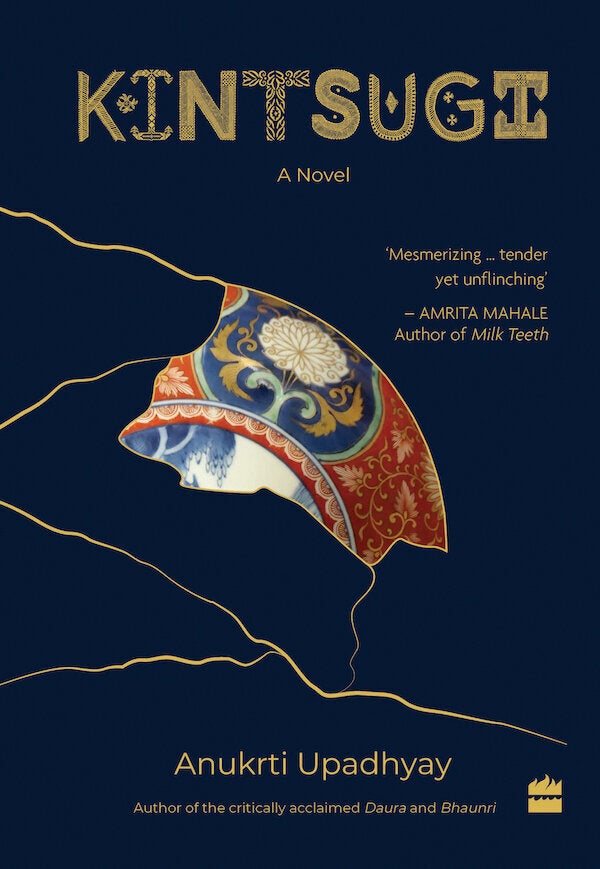
“Kintsugi” is one of those porous words that, having been understood once, is comfortably remembered even untranslated. Literally meaning “golden joinery”, it is the name of a Japanese technique of repairing broken pottery using a lacquer containing powdered gold or other metals. The metaphor inherent in this technique, perhaps more than the restored objects themselves, has popularized the concept. Like the symbolism of the phoenix, that of kintsugi too is internalized upon first encountering it, allowing us to project upon the technique our fractures and our resilience.
In Anukrti Upadhyay’s novel of the same name, it is but one form of jewel-craft among many, garnering only a fleeting but careful mention in the plot. Amidst highly detailed descriptions of enamel work, stone-setting and engraving, kintsugi appears only in a photograph in a book, and in a brief conversation that ensues. A young Indian girl wonders whether it is wastage to repair a bowl that cannot hold water, and her “Japani Jiji” responds philosophically, “Not all vessels are meant to hold water, some are for allowing water to seep away.”
Upadhyay’s Kintsugi opens in a jeweller’s gaddi in Jaipur—a workshop in a neighbourhood replete with them, where “everyone knew that women were not allowed to learn the craft of goldsmiths and artisans”. Here, a young American woman of Japanese and Korean heritage named Haruko is accepted as an apprentice by the cousins Madanji and Munnaji, in an anomalous favour to one of their patrons. The latter, a master kundansaaz, mentors her in lapidary work, and she moves into his home when she breaks her leg in a street accident. Here, Munnaji’s teenaged daughter Leela tends to and befriends her, and in turn is taught the art that her father had never considered passing down to her. Munnaji does not discourage what he thinks of as a hobby at first, amused by his daughter drawing designs while sitting with his injured student, but life’s vagaries lead to Leela becoming an artisan herself.
In this novel of intertwined storylines, Meena’s opens in an atmospheric way—she is on the road with a companion, leaving Tokyo for the hills, and something about the nature of their relationship is clear right from the opening lines, foreshadowing the narrator’s own realisation of it. Meena is a literature student from Jaipur, engaged to a doctor through an arrangement between their families, but pursuing a life unlike any she was told she could have. Haruko, Meena and Leela are the three protagonists of Kintsugi, and their stories are rounded out by the perspectives of Prakash and Hajime, who are men who come to know some or all of them well, as well as a woman named Yuri.

In this novel named after ruptures and remakings, the most striking breaks that some of its characters make are from the expectations they were raised with. At first, it seems that the catalyst for both Leela and Meena’s rebellions are the influences of foreign women whom they encounter. Both raised in Jaipur, and born some years apart, the two never meet, although Leela does hear about Meena through Prakash, the doctor who treats Haruko’s leg. Late in the novel, through his eyes, Meena’s uniqueness and non-conformity are revealed to have been inherent in her since childhood. Not so with Leela, who blooms under tutelage (first with Haruko, and then with a kindly tenant) and then finds her own footing. One of the finer points that Kintsugi makes is that transformation is always possible, for anyone, regardless of whether they were predisposed to the idea or otherwise.
The novel is ever alert to the patriarchy of Leela and Meena’s society and how it shapes everything therein. Leela, having learned her craft even without her father’s approval, is treated in a sexist way by others in her industry. Rather than receiving commissions, she is given poorly-set pieces to repair because “You have a housewife’s skill to fix and repair. Women are handy at mending.” When Tayaji, her parents’ tenant, offers to teach her the intricate thewa style, he tells her that not only had his sons not wanted to learn his art, preferring more fast-paced careers, but that his own father had been highly secretive about his work. Between the tradition of inculcating only men into jewellery work, and the various forms of gatekeeping and hierarchy within the same, it was the techniques themselves that had gone into decline. These complex dynamics are explored adeptly. There are also subtle poetic flourishes that gild the story’s more complicated moments, such as when one of the women, having been somewhat taken advantage of by an older man she is attracted to, recalls how it was the strap of his watch—a piece of functional jewellery also used by men—digging into her back through their coupling that was that encounter’s most vivid sensation. In other places, the ubiquity of the gender disparity slips through perhaps even unconsciously, and even oddly, as when the phrase “woman doctor” is used in a chapter in Haruko’s storyline, or how Munnaji’s wife is never named.

Still, when Meena recalls how her betrothed’s mother used to say, “Girls are like clay. I have kept mine soft, you can mould them as you like”, what comes to mind is that moulded clay pots enter kilns, where heat hardens them, and then they are liable to cracks—which can, if one has the imagination and the means, be filled with gold. In this book, as in the world, there are those who see the clay, and those who see the pot—just as there are those who stop seeing beyond the crevices, and those who take the chance to fill them with gold.
Despite the span of the world that this novel contains—travelling from the bazaars of Jaipur to the mountains of Kyoto to Singapore’s bustle and as far as Selingan Island in Borneo, described by Haruko in a palette of gem tones (“turquoise and aquamarine set in uneven waves, clusters of peridots, a shimmering white mother-of-pearl base, a necklace called Selingan!”)—it lattices its characters together with twists of fate that speak not so much about the world’s smallness, but more so about the serendipitous and sometimes inexplicable linkages that hold together human circuitries.
Kintsugi is a delicate work about the many ways the heart remakes itself, that like an ornament slowly being chiseled and laid takes time to reveal its final shape. Yet by its end—an almost quirky yet entirely befitting end, in which a cameo character reveals a secret of life—its artistry is evident, and despite its title, seamlessly expressed.